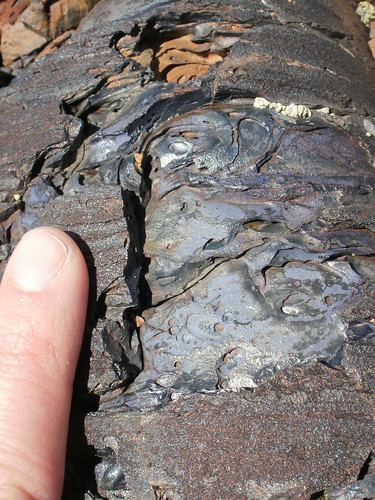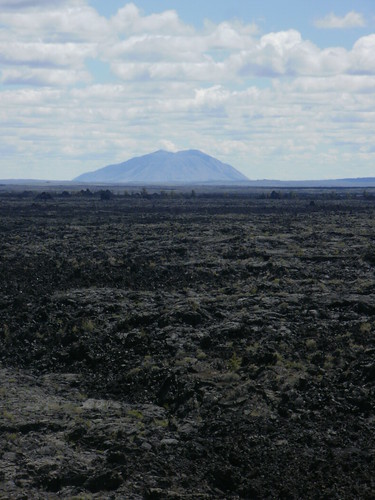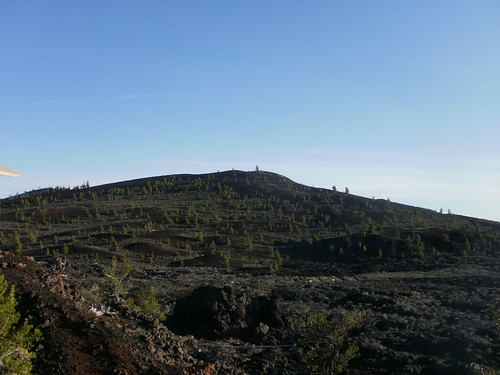“… a weird and scenic landscape peculiar to itself” was how President Calvin Coolidge described Craters of the Moon when he proclaimed it a National Monument in May of 1924. For my entry in the Accretionary Wedge #34, hosted by the lovely Dana Hunter over at En Tequila Es Verdad, I'd like to talk a little bit about some of the weird things we have here!
In 2000, the original boundaries of the Monument were expanded to overlap with an area of BLM land, and the area is now managed cooperatively by the NPS and the BLM, and is now a National Monument and Preserve instead. I’m working this summer for the BLM, but am stationed at the NPS Monument, to increase knowledge of this cooperative management. *
The name and managing organization may have changed, but the landscape remains, well, weird. And scenic.
Craters of the Moon is comprised of about 60 lava flows covering 54,000 acres, and spanning 13,000 year of time. This is the most recent area of volcanism on the Eastern Snake River Plain; altogether, the sheer mass of lava erupted throughout the ESRP has depressed the crust, resulting in a (mostly) flat valley 100 km wide. The eruptions at Craters of the Moon are the result of a 52 mile long tear where two plates of the Earth’s crust pulled away from each other, much like in Iceland or sub-Saharan Africa. The volcanoes in this picture are cinder cones that formed alongside the Great Rift.
This picture shows a close-up of the same lava pictured above. This is the Blue Dragon flow, named because it’s spiny texture and blue glass coating reminded early explorers of the skin of a blue dragon. The spiny texture is the result of bubbles in the lava being stretched and popped as the flow moved; the origin of the blue glass is still unknown, although it is suspected to either be the result of higher than normal titanium concentrations or a process similar to “glazing” a pot.
This picture illustrates another reason why Craters of the Moon is weird: bimodal volcanism. In the foreground, we have the fluid basaltic lava flows of Craters of the Moon, and, in the background, the 800 meter tall rhyolitic dome of Big Southern Butte (which lies outside the monument.) This butte was formed when very viscous lava flows piled upon one another. (It is also thought to extend about 1000 meters below the surface of the earth, but has isostatically sunk due to it’s weight.)
The compositions of these two lava types are about as disparate as lava types can get: basalt has low concentrations of silica, and rhyolite has high concentrations of silica. It is suspected that, in this location, the two lavas come from roughly the same origin, but proceeded through different paths through the Earth, which resulted in differing compositions. They both are a result of the Yellowstone Hot Spot heating the asthenosphere as the North American plate passed above it. The rhyolitic lava travelled up through the continental crust above, melting it and absorbing the silica. Later, when crustal extension of the basin and range province stretched the area out, the silica-poor crust melted (mainly by decompression), and cracked open, creating the rift zone at Craters of the Moon. Gravity readings under Craters of the Moon suggest that there may be a thick sill of gabbro, that was once part of a reservoir for feeding the basalt flows above the surface.
Another really weird part of Craters of the Moon are the blocks of lava shown in the center of this picture. One of the more recent flows of the North Crater broke apart the crater wall, and rafted chunks of the wall along the top of the flow. These crater wall pieces dot the landscape in an eerie monolithic fashion, like something out of 2001: A Space Odyssey.
And here’s the North Crater itself, with one of the rafted blocks in the foreground. The area where the flow broke out is on the back and right side of the cone seen here. The asymmetrical shape of this cone is due to the cinders accumulating on the downwind side of the vent.
Early emigrants passing through this area by wagon train described this area as “black vomit.” These early emigrants, after travelling across a harsh and demanding area, almost entirely void of water or shelter, were too weary to contemplate appreciate the landscape. Those of us privileged enough to visit in this modern day find it easier to look past the difficult environment to the gorgeous volcanic scenery and awesomely weird geology.
* Normally, I wouldn't say who I work for, however my lawyer-mother recommended I do. Plus, it's pretty stinking obvious. Please don't think anything I say is the official opinion of the BLM or the NPS, and remember that I'm still learning about this area and geology generally. Also, please don't stalk me. If you're in the area, however, please feel free to say hi!






4 comments:
Perhaps unsurprisingly, the volcanics on the Snake River Plain get younger to the east. A really bizarre finding, though, is that that trend is mirrored in Oregon. The volcanics, at least the rhyolite domes, get younger to the west! This article came out when I was an undergrad, and I've found the whole text to be very useful in exploring central and eastern Oregon and nearby areas:
http://www.cr.nps.gov/history/online_books/geology/publications/circ/838/sec5.htm
Here's the table of contents, which links to other articles and road guides:
http://www.cr.nps.gov/history/online_books/geology/publications/circ/838/contents.htm
What a geologically interesting place to work. So what are you doing there?
Thanks for the photos and the descriptions. I visited the area many years ago as a boy, and it left something of an impression to this day. Coolidge was right, for once. Hopefully, I'll be able to visit it again someday.
This sentence from the article didn't make much sense to me:
basalt has low concentrations of silica, and rhyolite has low concentrations of silica.
It looks like that's a typo. I say that, because both the sentence and the rest of the paragraph suggest to me that you were trying to contrast the two types of rock, and because the Wikipedia entry says that rhyolite is "Rhyolite is an igneous, volcanic (extrusive) rock, of felsic (silica-rich) composition (typically [greater than] 69% SiO2".
Whoa, thanks for catching that, Cujo359! That'll teach me to write posts while drinking beer...
That looks like a really awesome resource, Lockwood! I get over to Oregon more frequently than ever, now that I live in Idaho!
Post a Comment